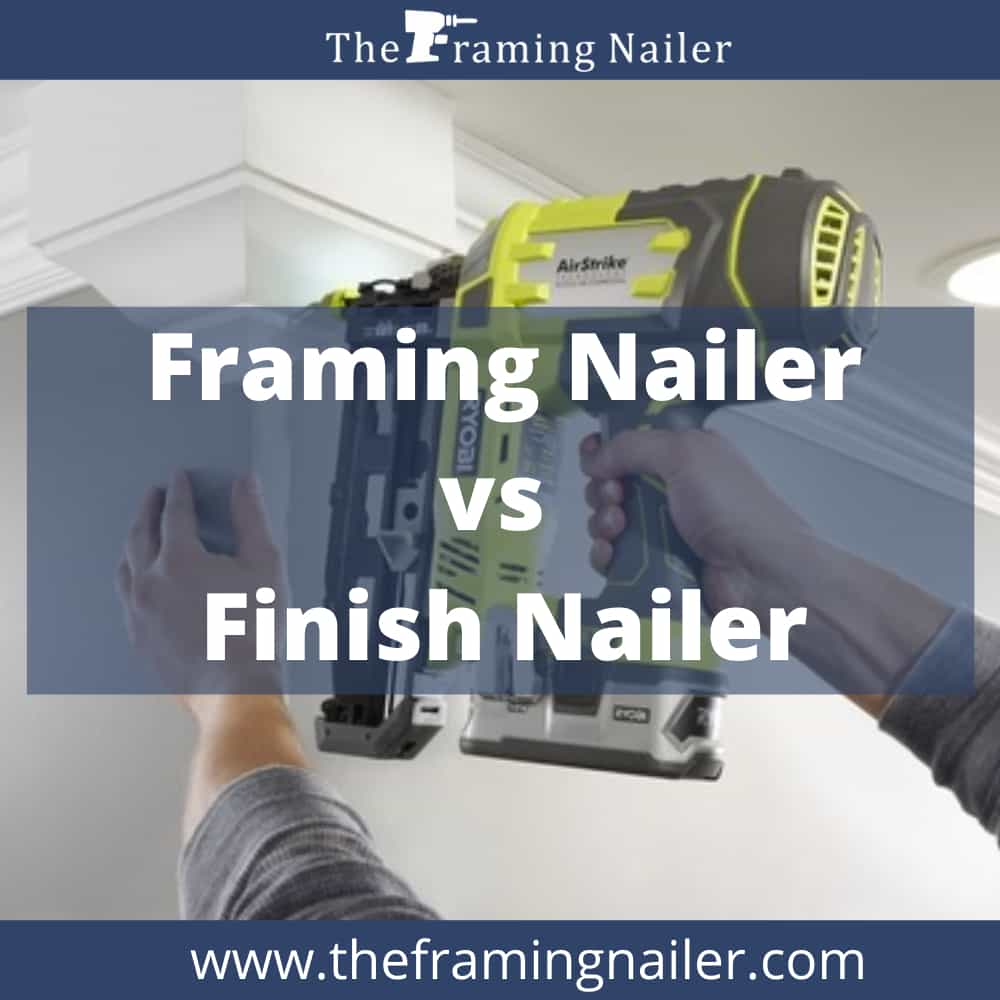The framing nailers and finish nailers are two different types of the tool of one family. Both are meant for performing different but specialized tasks in woodworking. In comparison to framing nailer vs finish nailer, we can explain that both the tools perform distinct tasks.
Although sometimes the shape and design of different nail guns are the same yet their applications are different. The same look sometimes confused the people that framing nailers and finish nailers are one and the same thing.
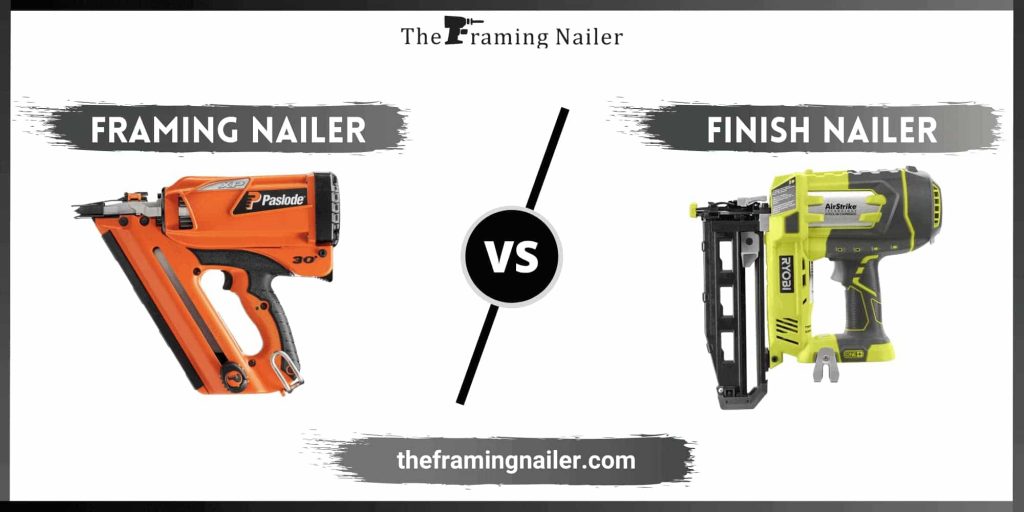
The nail guns were invented in the 1950s and took the place of hammer very quickly. The framing nailers perform heavy-duty work mostly at the beginning of the project. Whereas finish nailers are designed for small and finishing jobs such as installing baseboards, crown molding, etc.
The framing nailer is used for fixing large size nails as framing nailer mainly used for the construction of houses. But finish nailers use nails of shorter length contrary to framing nailers. While in the discussion of framing nailer vs finish nailer we can clarify that both the tools are not interchangeable.
Table of Contents
Framing Nailer VS Finish Nailer
1-Framing Nailer:
The framing nailer is a beast in the family of nail guns. A framing nailer is a heavy-duty tool that every woodworker loves to have. Framing nailer has made the life of woodworkers comfortable. Before framing nailers, the use of a hammer was common that consumed so much of energy and time. So now these framing nailers prove very helpful in the construction of houses. Framing nailers shoots the nail of 1 ¼ to 3 ½ inches. You can also check the list of best framing nailers
The framing nailer is divided into two subcategories i.e. Clipped Head And Round Head. The clipped head nail’s head is “clipped” off and is “D” shaped while the Roundhead nail has a full head. Clipped head nailer holds more nails then round head one’s. While Roundhead nails are the most common types of nails and we all have used them at times.
Application:
- Ideal for construction of houses
- Wood fencing
- Handy for large projects
- Framing houses
Types:
- Pneumatic framing nailer
- Cordless framing nailer
A pneumatic framing nailer is the first type of framing nailer. For working with a pneumatic framing nail gun you must have an air compressor. You have to deal with hoses too. If you don’t have any air compressor then you won’t be able to operate this tool. You can also check best pneumatic framing nailer.
Cordless Framing Nailer:
The second type of framing nailer is a cordless framing nailer. Some people may also call this as battery operated framing nailer. Cordless framing nailer gun gives the user complete freedom as there is no need for an air compressor for its operation and you don’t have to deal with hoses too. All you need is a battery or fuel cell and sometimes both for its operation.
 Bostitch F21PL is a quality product of the Bostitch company. This is a 21-degree plastic collated framing nailer that operates with the pressure of 80-120 PSI. Its magazine has the capacity of holding 60 nails which is a really good number.
Bostitch F21PL is a quality product of the Bostitch company. This is a 21-degree plastic collated framing nailer that operates with the pressure of 80-120 PSI. Its magazine has the capacity of holding 60 nails which is a really good number. Two in one:
Bostitch F21PL is two in one nailer. It can be used for both framing as well as a metal connector quite easily. It comes with two quick nose pieces that will help to convert the tool either for framing or as a metal connector depending upon the need of the user.
Patented Push Button:
Bostitch F21PL has a feature of shooting the nail at the desired level into the wood with just push of a button. Now you can easily adjust the depth of the nail for sinking with this quality feature. This feature enhances the beauty of this tool.
- Adjustable rafter hook
- 7 years limited warranty
- Tool-less depth adjustment
- No actuation mode selector
- No anti dry fire mechanism
 Metabo HPT NR1890DR is a cordless framing nailer with a brushless motor that helps to drive the nails into the lumber easily. It comes with a 3.0Ah lithium-ion battery, so you don’t have to worry about dirty hoses and compressors.
Metabo HPT NR1890DR is a cordless framing nailer with a brushless motor that helps to drive the nails into the lumber easily. It comes with a 3.0Ah lithium-ion battery, so you don’t have to worry about dirty hoses and compressors. Air spring system:
It has a unique air spring system that uses compressed air to drive the nail with zero ramp-up time and also has increased its speed.
Control panel:
This is a really great thing in this framing gun that very few nailers possess. It has a control panel fitted with a power switch button for the tool and few other options like battery charge indicator and selective actuation switch on this panel. You can also check best cordless framing nailers.
Selective actuation:
Many tools come with different triggers to operate the nailer in various modes. But this tool comes with the selective actuation switch that is located on the control panel which helps an easy transition from sequential to bump mode.
Safety:
Metabo HPT NR1890DR comes with a trigger lock that serves as a safeguard for the users. This feature protects the user from accidental fire. It has a tool-less depth adjustment feature that helps to sink the nail into the desired level.
- Air spring drive system
- Mode selector
- Tool-less depth adjustment
- May be high in price
- No tool less jam clearance
- Not a light one
2-Finish Nailer:
A finish nailer is one of the family members of the nail guns and is used for small scale projects and is typically meant for finishing jobs. Finish nailers can not be used for heavy-duty projects like that of framing nailers. It is important to note that the tool creates aesthetic sense in the work.
The finish nailer accepts nails of 15 or 16 gauge. Let me clarify the difference between the different number of gauge nails. The greater the number of gauges, the thinner the nail will be. Let’s look at the example. If you have two nails one is of 15 gauge and the other is of 16 gauge then which one will be thinner?. The 16 gauge will be thinner because the greater the number of gauge thinner the nail will be. Most people become confused about this.
Application:
- Good for finishing jobs
- Handy for cabinet and furniture work
- Crown molding
- Installing baseboards
An interesting feature of the finish nailer is that it could be angled or straight one. It all depends on the choice of the user which type of finish nailer he wants to buy. However, these two types are meant for a bit different jobs.
Angled Finish Nailer: 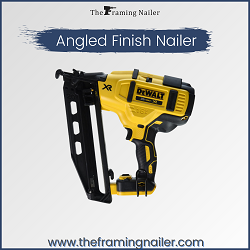
Angled finish nailer proves handy when working in tight spaces. The magazine of the finish nailer is fitted at some angle. Usually, the angle of these finish nailers is between 21 and 34 degrees. Since it is an angled nailer so you must have appropriate nails to operate this nailer.
The nails of angled finish nailers are somewhat thicker and have some good holding power but still less than framing nailer. If you have to work in tight spaces then the angled finishing nail gun will suit you a lot. However, it’s a bit expensive and its nails are costly too.
Straight Finish Nailer: 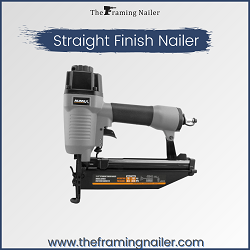
A straight finish nailer is a nailer that has an angle less magazine or maybe at 90 degrees. Straight finish nailers are not meant for use in tight spaces. However, they are cheaper than angled ones. Straight finishing gun uses thin nails in comparison to an angled nailer.
Types:
- Pneumatic finish nailer
- Cordless finish nailer
Pneumatic Finish Nailer:
In this first type of finish nailer, you need an air compressor for its working. If you don’t have an air compressor you won’t be able to use the pneumatic finish nail gun. Pneumatic nailers are always powerful and can do the job quickly and accurately.
Cordless Finish Nailer:
A cordless finish nailer is the innovative type of finish nailer. You can also call this as battery-powered finishing nailer. For a cordless finish nailer, you neither need an air compressor nor have to deal with air hoses. Dealing with hoses and compressors irritates the people sometimes. All you need a battery or fuel cell and sometimes both for the working of a cordless finish nailer.
Comparison Chart & Key Differences
| FEATURES | FRAMING NAILER | FINISH NAILER |
|---|---|---|
| Nail Length | 1.25 to 3.5 inches | 1 to 2.5 inches |
| Nail Gauge | 8 to 11.5 gauge | 14 to 16 gauge |
| Heavy-duty Jobs | Yes | No |
| Aesthetic Work | No | Yes |
| Pneumatic or Cordless | Both Available | Both Available |
| Uses | Great for heavy duty jobs like construction of houses. | Great for finishing jobs and crown molding |
Nail Size:
The first difference between framing nailer and finish nailer is in the size of the nail which they use as the size of the nails for framing nailer is different from the finish nailer because both have different purposes and usages. The framing gun uses nails of larger size than the finishing nailer because it performs heavy-duty such as the construction of houses, that requires long length nails for great holding power.
The finish nailer uses nails of 1 to 2.5 inches. The finish nail gun uses nails of shorter length than the framing nailer because it performs a small job and finishing work. Although these size nails will provide a good holding power but still less than the framing nailer.
Applications:
A framing nailer performs in large size projects like construction of houses, building fences, roof sheathing, etc. While the finish gun performs in small projects and finishing jobs like installing baseboards, crown molding, etc. The framing nailer and finish nailer carry out a distinct job so we can not use one tool in place of the other.
Durability:
For building houses and big size structures, you have to use nails of good strength and size. If you fail to use such items you will invite disaster resulting in loss of life and property. But for fixing nails of large size and good strength, you need a powerful tool. The manufacturers of framing nailers design the tool to perform heavy-duty jobs.
The finisher nail gun fixes thin and small size nails for the preparation of furniture, fixing of the crown, and making reeling of stairs, it performs decoration work on pieces of furniture, etc. It accomplishes delicate and complicated woodwork.
When are they used:
Both the nailers possess different capabilities to perform the job so the user utilizes it at the appropriate time and stage of the project. If we break the project into two parts i.e. initial stage and finishing stage, the framing nailer is used in the first stage when structures or frames are built by joining beams and large lumbers. The framing nailers perform the heavy-duty task where strength and durability matters.
After building the structures or frames the project enters into the second stage where finishing work is required to be performed. So at this stage, we need finish nailer. Thus we carry out the work of molding, crowning, etc. to give the woodwork a better look after finishing the work.
Price:
The cost of framing nailer and finish nailer may vary from model to model. The nailers having all the good features will have a high price as compared to those with few features.
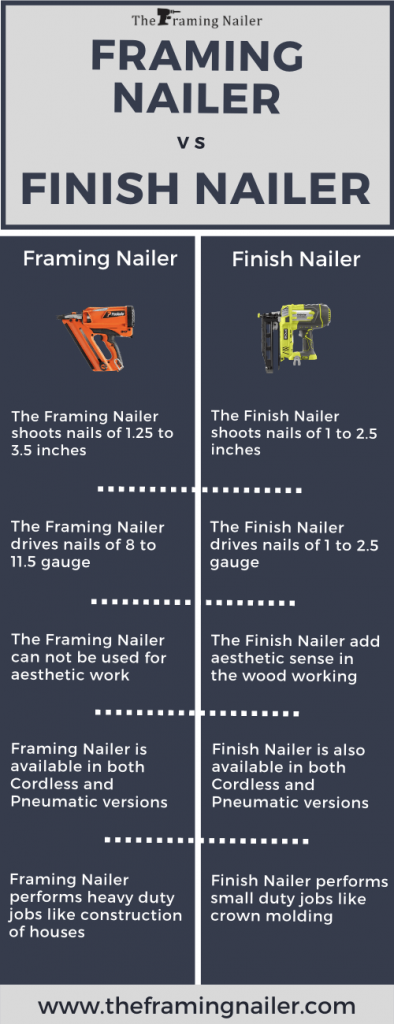
After discussing the difference between framing nailer vs finish nailer, there are few other specs and features one should know if one wants to buy the framing nailer or finish nailer. Because one does not purchase these tools very often so one should choose a proper tool to utilize it as per genuine requirement.
Cordless Nailer:
Cordless nailers are those nailers that don’t require any air compressor for its operation. You don’t have to deal with hoses to operate the cordless nailers. All you need is a battery or fuel cell and sometimes both for its working. In this way, cordless nailers give freedom to users from hoses and compressors.
Pneumatic nailer:
Pneumatic nailers are those nailers that require an air compressor for their working. You have to deal with hoses and air compressors, otherwise, you won’t be able to work with it.
Operating Modes:
There are two operating modes for nailers, one is sequential, and the other is bump mode. The sequential mode is used for a single fire while bump mode is used to finish the things quickly. Some nailers come with two triggers for these two modes. So you have to change the trigger in order to activate the different modes. While some nailers do come with a selective actuation switch. This switch helps an easy transition from sequential to bump mode. So you don’t have to worry about different triggers for different modes.
Tool-less depth adjustment:
Depth adjustment is the feature that facilitates the user to sink the nail into the wood at the desired level. Many nailers come with tool-less depth adjustment feature means you don’t need any tool to adjust the sinking of the nail, you can easily adjust it manually.
Jam clearance:
Jamming is a common thing in nailers. If you are a regular nailer user you must have faced this. Jamming can be annoying sometimes and can break the flow of work, so nailers must have an easy jam clearance mechanism so that users can easily remove this fault. Many nailers have a tool-less jam clearance feature which is a great help for the users.
Requirement:
All the nailers almost look the same, but they aren’t used for the same purposes, as above we have briefly described framing nailer vs finish nailer, so you must understand their differences and your requirements and usages. You can not use a framing nailer in place of a finish nailer and finish nailer in place of a framing nailer. So while purchasing a nailer you must know your requirements and the usages of the tool.

